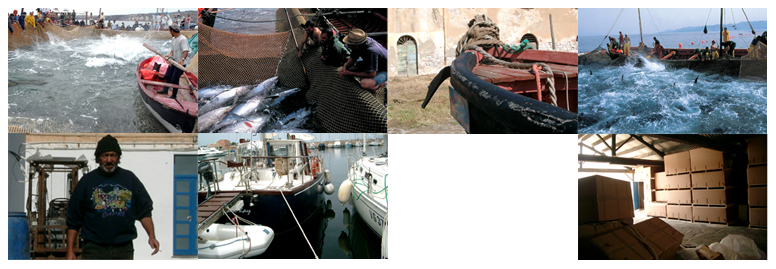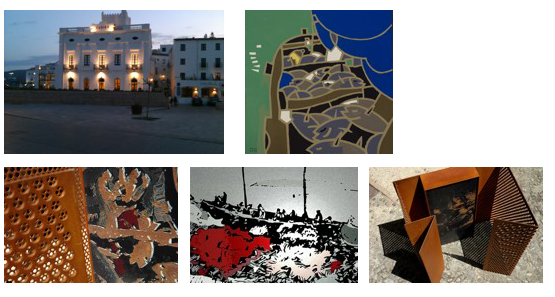
CARLOFORTE (ITALY). ALMADRAVA PEOPLE
Fragment of the homonym tale by Joan C. Roca Sans
“La mattanza” (The Cull)
A diver pulls on the rope that tethers him to the boat. The fish are in the net. The sailors yell and shout. “¡Pull the net up!, pull the net up more” orders the rais, “¡Net, net!! ¡Pull, pull, pull! ”. Soon the tumultuous treasure of fish surfaces, showing their plump and shiny flesh in the air and sun.
At an order from the rais they stop and tie the ends of the net to the vascelli boats. There follows a moment of calm and preparation. The silence is suddenly broken by the shout from the rais ordering the start of the fierce and furious battle between man and his prey.
The barges are only a few metres away from each other, and in the middle the sea is boiling. Noise, water and foam. The silvery giants thrash about desperate to escape their agony. But it’s too late. The impatient water tonnarotti have already jumped to the net.
You have to hurry. “¡Not one fish left in the net, not a single one!”, the rais orders. Right in the middle is the musciara, a small dark boat painted light blue inside, handled by a sailor, from where the rais points out the larger tunas swirling around the little boat. The tuna fishermen harpoon them with a long hook and at the same time others grab them with much smaller hooks to raise them on-board.
The bodies of the tuna are floundering, they are hitting each other, shaking as if possessed, with jumps and feints they appear and disappear among the green and blue foam of the sea. The sunshine is erratically reflected on their silvery scales every time they emerge above the water. The roar of blows, thrusts, clashes, shouts and gestures accompanies the scene while the sea is being dyed red, in a ceremony that is fully inscribed in the time and space of violent depredations. The tuna fishermen, sweating and frenzied, handle and collect the prey with experience. The adrenaline rises and the water seems to boil.
The rais and his companion leave the musciara and climb onto one of the barges. The work of hoisting the tuna on board requires tremendous coordination, it is a team effort and one false move can cause an accident. Some let themselves fall back, using the death throes of the fish to their benefit, and the tunas end up on the wood of the barges, where they still struggle for a little while. Several sailors fight one on one with some of the tunas that are nearly twice the weight of a man. And a fisherman goes from one side to another jumping from tuna to tuna, to bleed them with an incisive dagger blow. The encircling nets end up completely dyed by reddish foam, and the barges are filled with hundreds of dying creatures snatched from their world.
Tuna fishing is very much a sacrificial rite: the fight, the death, and the triumph. It is the tribute paid by the sea before the ‘enamoured’ tunas stop ‘running’ in search of warm waters to reproduce and continue the species.
Two empty moons
What if someone comes?” Alain mumbled so that he would not be heard; but his protests stopped when she, still in her bikini, knelt down and got ready to devour the salty prey which, feeling a desire that was greater than death, remained radically suspended from the final limits of consciousness.
Although he wasn’t yet aware of it, Alain had just entered into the Antechamber of Death. Isabelle’s large eyes, full of darkness, were fixed on him like two empty moons. Curled up on one end of the bunk bed, he once again felt that pain in his chest, which grew in intensity, until it disappeared. He finally fell asleep, looking at the large, twinkling stars through the bull’s eye window, desperately seeking eternity.
A blinding bolt of lightning went through Alain’s head and his body was in shock. Sitting up suddenly, he grabbed Isabelle’s neck, her soft, firm neck, in which he could feel the flow of her inconstant personality as he squeezed his hands. This was crazy! Loosening the pressure, all fight left him and the pressure became slacker and slacker until it stopped completely. “Alain, Isabelle, we have to go! Massimo’s waiting in the car.” Rose called out from the deck.
“You’re a bastard, a coward! You haven’t heard the last of this!” Isabelle threatened, picking up her bag, as she got out of bed and shook her head to separate it from the unmanageable hate that filled her heart.
“What’s up with Alain? Isn’t he coming?”
“No, Rose, Alain doesn’t feel well. Let’s go, it’s getting late.” Isabelle replied, throwing him a glance of barely contained scorn, not knowing it would be the last one, because death was already reaching out for him and there was no escape now.
When they got back from the tuna fish mattanza, they found Alain, still naked, on the floor of the cabin. In his hand, he was firmly holding something which Isabelle managed to extract from his grasp. It was a blister of sublingual nitroglycerin, unopened, intact. She put it into her bag. She did not know what to say. How should she be feeling? What did everyone expect her to do? What would she say to “Petit Pierre”? She could love, but she hadn’t been able to love him, she lied to herself. Next time it will be different, she lied to herself again.
But what if it wasn’t? What if she really was unable to love anyone? She asked herself all these questions with brutal truthfulness and remained coldly perplexed sitting on the deck bench until someone came to deal with the corpse.
© JC Roca Sans
PAINTING
The Almadrava Fishing
Alain and Isabelle
SCULPTURE
Project 1
Project 2
Project 3
DIGITAL DRAWING
The Trap
Ermoupoli Project: Exhibition at the “Societat l’Amistat” of Cadaqués from JC Roca Sans on Vimeo.
THE ERMOUPOLI PROJECT ARRIVES TO CADAQUES
The ‘Societat l’Amistat’ presents ‘The Trap’, work in progress of JC ROCA SANS

The ‘Societat l’Amistat’ would like to present the following exhibition:
THE TRAP
Based on the story “Carloforte. Gent d’almadrava “, this is an unedited stage of the Ermóupoli Project, an ambitious work in progress of JC ROCA SANS.
Exhibition 1st September to 13th October 2012.
Opening on 8th September, the Village Festival of Cadaqués, at 19.00h Opening hours 11.00 to 13.00h / 17.00 to 21.00h
Closed on Mondays. Plaça Dr. Trèmols nº 1, 17488 Cadaqués. societatlamistatcdq.blogspot.com societat.lamistat.cdq@gmail.com
THE TUNA TRAP RETURNS TO CADAQUÉS
This proposal is centred around the bluefin tuna, a species threatened with extinction by the greed of countries that speculate with fishing quotas, depending on their economic interests. For centuries, man reaped the rewards of the sea, capturing the tuna using a method known as the ‘almadraba’ or the tuna trap. This old and sustainable method of fishing has gradually disappeared under the pressure of the purse seine fleets, which capture this creature in their thousands in order to fatten them up and kill them when appropriate. Currently, the only tuna trap left in the Mediterranean is the Italian ‘tonnara’ of La Punta, in Carloforte, south of Sardinia.
In order to transcend what would otherwise simply be a documentary, JC ROCA SANS has built a dual story. Fascinated by the art of the tuna trap and based on the fact that the bluefin tuna is caught when commuting from the Atlantic to the Mediterranean, where it comes looking for warmer waters in which to breed, he reaches the poetic conclusion that this animal meets its death thanks to love. This raises a parallel narrative that explains the story of a doctor from Bordeaux who, having been invited to Carloforte by some friends, and hoping to win back his ex-wife, is lured into a psychological trap where he ends up meeting his death. Was it an accident or suicide? Everything is open to interpretation by the reader, who can find the complete story in PDF at the same exhibition and also at www.rocasans.net. (Carloforte).
IMAGES
The visual context of “The Trap” is double faceted: one series of paintings that interpret the sexual drama between the starring couple and, another series that interprets the art of the tuna trap as a true marine dance of death. The second floor, dedicated to new technology, features a collection of 20 digital etchings on rice paper and seven iron plate sculptures which are digitally lit. The short animated film “The Trap” completes the ensemble.
JC ROCA SANS
We should scrutinse JC ROCA SANS’ (Barcelona 1946) artistic portrayal in the light of its internal consistency, as an artist who has lived firsthand, in Germany and in the U.S., the postmodern experience of the eighties and who nevertheless, or perhaps thanks to this, has always built his own language, not from the usual tried and tested methods, but from his own convictions; drawing and painting life, love and death as recurring themes, in an attempt to offer a personal view of the world and the human condition.
THE LEGACY OF THE AVANT-GARDE
JC Roca Sans


A MULTIMEDIA HORIZON
There is no doubt that in future art will increasingly incorporate more and more new media and technological innovations, which means that the process of hybridization of man and the machine will continue to grow. We are therefore on the threshold of a radical transformation due, amongst other reasons, to the fusion of genres that technological development entails. Language, visual image and sound are integrated within a trans-media horizon, using computers, video, social networks and the different types of emerging installations, which are a mixture of them all. And the phenomenon has only just started.
THE IMPORTANCE OF THE NARRATIVE
These days the arts register an increasingly more noticeable narrative element, definitely due to the impact caused by the expansion of the new electronic and digital culture. Words and images are used to tell stories. Bits are also used, as they offer the opportunity to reach new levels in representation and light focus, not only because they can use them to highlight supporting structures such as iron, marble or metacrylic, but also because by removing the digital content, they can turn this information into emotion by playing with contrasts.
EXPERIENCES FEATURING ARTIFICIAL INTELLIGENCE
A new paradigm of interaction between art and technology is emerging before our eyes. We post-modern artists, contrary to the avant-garde, have never identified substantial differences between old and new, regarding them and “two sides of the same coin”.
Experiences with the artificial intelligence of the milling machines that feature in the three-dimensional pieces of “The Trap” are clear examples of the fact that, from a philosophical point of view, art and technology share the same ontological space, that of simulation and appearance. By means of CAD-CAM programmes, I identified sectors where the machines would follow a course, but allowed them the freedom to choose how.
I think that drawing, painting and sculpture are radical forms of human expression in the visual representation field, similar to the significance of poetry in the universe of language. Therefore these original forms of expression can never disappear, even when fused with technology. In fact, in the last one hundred and fifty years, the new media support have not cancelled out the old ones, but instead they have influenced each other, and so it continues.
THE LEGACY OF THE HISTORICAL AVANT-GARDE
Despite the fact that controversy and innovation are no longer the avant-garde (the trends date back to 1870), quite the contrary, they are academia, representative even, they have become “our” tradition, the aesthetic tradition of modern life.
Some relevant features of the avant-garde are still valid today. One of them is the concept of a compromise between art and the evolution of mankind. However, drawing from the emotion of the great ‘tales of emancipation’, the current idea of a project such as Ermóupoli obviously has to be more tangible and circumstantial, linked to the idea of communicating a personal view of life and the eventual transformation of collective consciousness.
Contemporary art is not only characterised by the absence of references, but above all by the love for experimentation, the understanding of the artistic experience as a fragment and as a fusion at different anthropological levels: emotion and concept, fun and seriousness, reason and feeling, order and chaos. JC Roca Sans
Cadaqués













































































